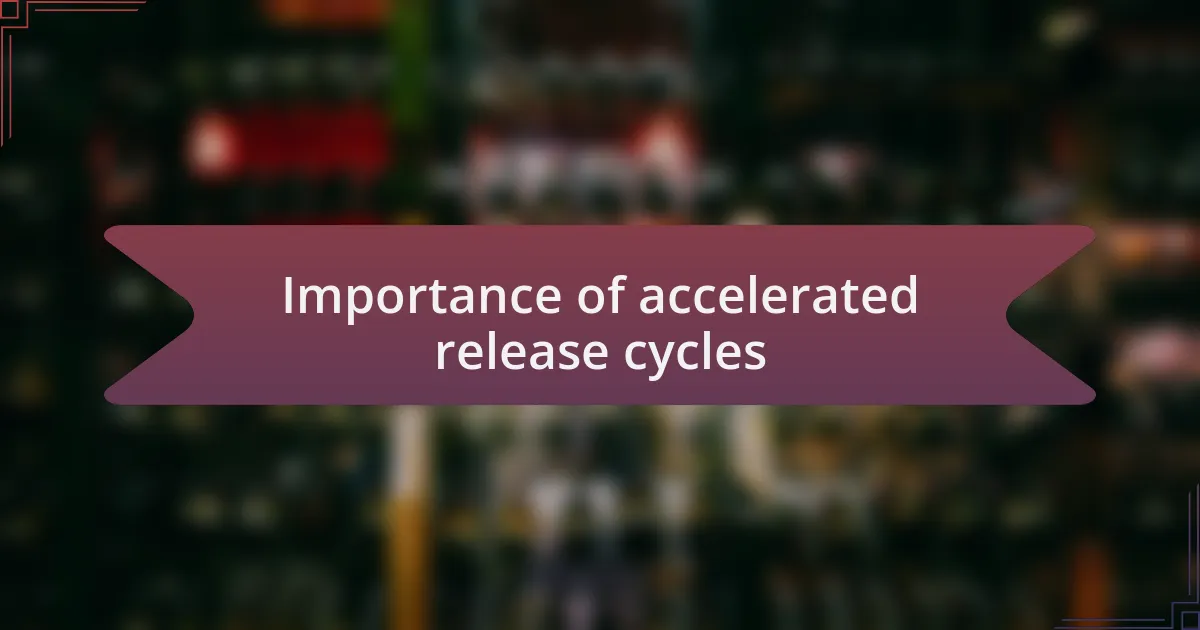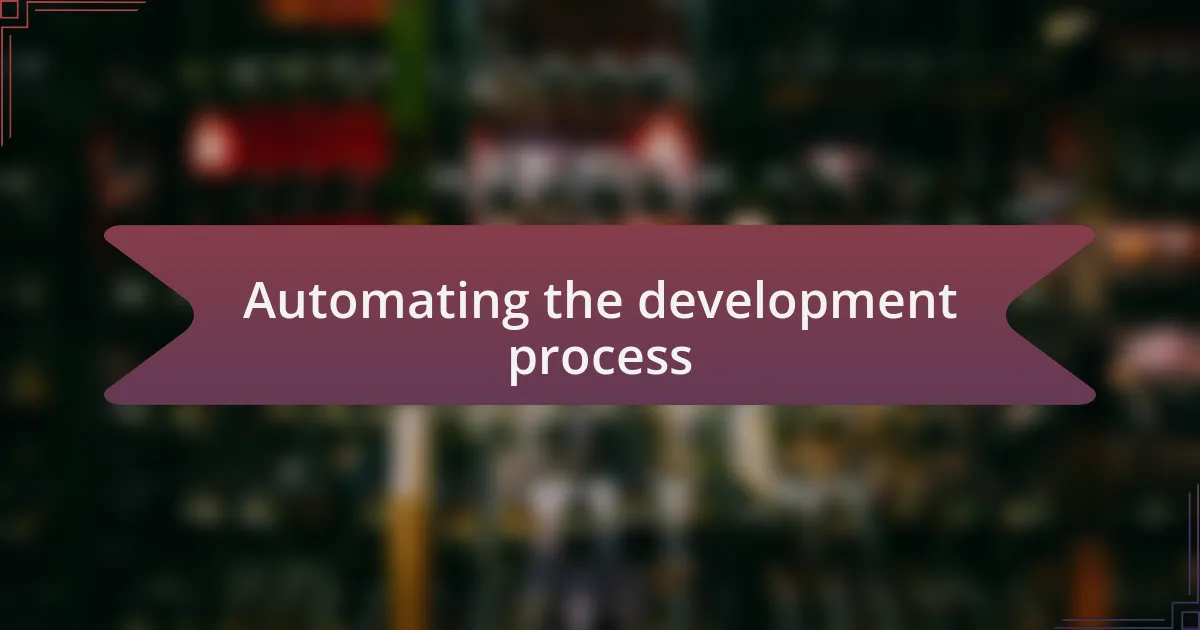Key takeaways:
- Understanding and implementing structured release cycles enhance software quality, team morale, and project success.
- Accelerated release cycles promote competitiveness and foster collaboration within development teams, allowing for rapid adaptation to user feedback.
- Utilizing Agile methodologies, such as daily stand-ups and flexibility in sprint goals, significantly improves communication and project outcomes.
- Automating processes, like CI/CD, reduces inefficiencies and boosts team engagement by allowing more focus on innovation.

Understanding release cycles in software
Release cycles in software development are crucial for managing how updates and new features are delivered to users. I still remember a project where we had a tight deadline, and understanding our release cycle was the key to success. By breaking the development process into manageable phases, we were able to focus on delivering value in each iteration.
Many people wonder why we can’t just release everything at once. From my experience, staggered release cycles allow for testing and feedback between iterations, which is essential for quality assurance. Once, I was involved in a project that implemented a continuous release cycle; the quick turnaround times and real-time feedback loops transformed our approach to software development.
When reflecting on the importance of structured release cycles, I realized they aren’t just about timelines; they also influence team morale. A smooth, predictable cycle can create a sense of accomplishment and momentum among developers. Have you ever worked on a project where the chaotic release process drained your enthusiasm? I have, and it taught me the value of a well-understood release strategy in keeping motivation and productivity high.

Importance of accelerated release cycles
Accelerated release cycles are vital for staying competitive in today’s fast-paced software landscape. I remember a project where we were able to roll out new features every few weeks instead of months. This not only kept our users engaged but also gave us the chance to quickly pivot based on their feedback. Have you ever noticed how rapidly user demands change? It’s crucial to adapt just as quickly.
Moreover, the speed of accelerated cycles enhances collaboration within development teams. I’ve seen teams that operate in shorter intervals foster a culture of continuous improvement, where everyone feels accountable for delivering quality. It’s exhilarating to witness team members become more proactive, sharing ideas and solutions in real-time, rather than waiting for a lengthy review process. Doesn’t it feel great to be part of something that evolves so quickly?
Finally, the efficiency gained through these cycles can significantly reduce the risks associated with software releases. I once worked on a project that implemented a rapid deployment approach, allowing us to identify and fix issues almost instantly. Reflecting on that experience, I realized that faster release cycles not only minimize the potential fallout from bugs but also empower teams to innovate without the fear of being stuck in long development phases. Isn’t that the kind of environment every developer dreams of?

Key strategies for faster releases
One effective strategy for achieving faster releases is adopting Agile methodologies. In my experience, implementing Scrum frameworks helped my team break down large projects into manageable sprints. I vividly recall the sense of accomplishment we felt at the end of each sprint review—a tangible reminder of what we could achieve in a short time. How could one not feel motivated when you see the fruits of your labor so frequently?
Another crucial aspect is automation in testing and deployment. I remember a specific instance when we integrated automated testing into our CI/CD pipeline. Initially, the learning curve was steep, but once established, it drastically reduced our release times. It was almost magical to witness how quickly we could catch bugs before they reached production. Isn’t it reassuring to know that you can release new features without the constant worry of hidden issues slipping through?
Finally, fostering a culture of open communication among team members is key. I’ve seen the difference firsthand when teams hold daily stand-ups to address challenges and share updates. There’s an undeniable energy in the air when everyone is aligned, pushing towards the same goal. Have you ever been part of a team where collaboration just clicks? It not only accelerates release cycles but also builds a sense of camaraderie that makes the entire process enjoyable.

Automating the development process
Automating the development process has transformed the way my team works. I recall the first time we implemented a tool for automated deployments; the efficiency was astonishing. Suddenly, what used to take hours could be executed in mere minutes. It felt like we had turned a corner, reducing stress and allowing more time for creative problem-solving. Isn’t it incredible how automation can free us up to focus on what we truly love—innovating?
I’ve also found that incorporating continuous integration (CI) tools has been a game-changer. For example, when we started using Jenkins, it felt like our workflow had gained superpowers. The feedback loop became instantaneous, which meant we could address issues on the fly rather than saving them for lengthy end-of-cycle reviews. Can you imagine how much smoother development would be if every stakeholder had real-time access to what’s happening?
Additionally, the emotional impact of automation shouldn’t be overlooked. I remember the relief in my team’s faces when tedious tasks were taken off their plates—suddenly, everyone was more engaged and driven. There’s a noticeable change in morale when the team can see their efforts resulting in quicker deployments. Does it not feel rewarding to know that every small automation leads to bigger wins? It’s this very connection to our work that continually fuels our passion for software development.

Using Agile methodologies effectively
One of the most effective ways I’ve found to use Agile methodologies is through regular stand-up meetings. These short, focused gatherings have transformed how my team communicates. I can still remember a time when our updates were scattered and misaligned; by adopting daily stand-ups, we created a rhythm that kept everyone on the same page. Have you ever noticed how a simple check-in can clear up confusion and build camaraderie?
In my experience, embracing flexibility is crucial. I recall a project where we faced unexpected setbacks, and rather than sticking rigidly to our planned approach, we adjusted our sprint goals. The result was not just a product that met client needs, but a team that felt empowered and resilient. Doesn’t it feel great to pivot when necessary, knowing that adaptability is a hallmark of Agile success?
Moreover, I can’t stress enough the importance of prioritizing customer feedback throughout the development process. I once saw a project falter simply because the team was too locked into their own vision and didn’t seek user input early enough. By incorporating feedback loops, we drastically improved our final product and strengthened our relationship with customers. Isn’t it fascinating how listening can lead to a deeper understanding and better outcomes?

Lessons learned from my experience
I’ve learned that the importance of teamwork cannot be overstated. I remember a project where we had a brilliant idea—but we all worked in silos. It wasn’t until we began pairing developers and designers that we saw our efforts blossom. Suddenly, our ideas merged and flourished. Doesn’t it make you wonder how much talent is untapped when collaboration isn’t prioritized?
Another key takeaway for me has been the value of retrospectives. Initially, I viewed them as mere formalities, but I learned they are powerful tools for growth. During one session, we uncovered a recurring issue that was slowing our progress. Addressing it not only improved our workflows but also fostered a culture of transparency and continuous improvement. Who would have thought that taking time to reflect could catalyze such significant change?
Lastly, I can’t emphasize enough the necessity for clear documentation. Early in my career, I often assumed everyone was on the same page. Yet, after experiencing projects stall due to unclear requirements, I realized the importance of well-maintained records. Creating clear, accessible documentation has saved countless hours of miscommunication and frustration. Don’t you agree that clarity is a cornerstone of effective collaboration?